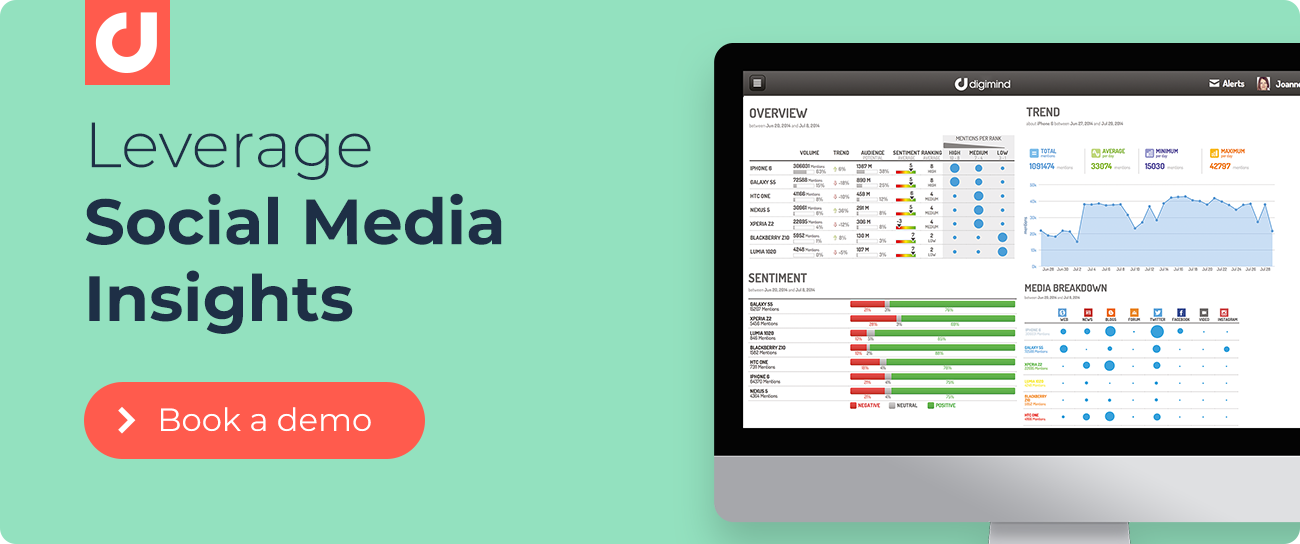5 Expertly-Crafted Strategies to Create Winning Content Using Social Listening
Simply Put, What’s “Social Listening”?
Saying you work in the field of marketing after someone asks you what you do for a living, might warrant a follow up inquiry regarding what specifically that entails. Simple enough for you to answer: marketing is MARKETING! And while, yes, there are many, many different roles within the broad spectrum of the profession, a good way to be brief and all-encompassing with your response would be to respond “We help businesses and brands connect with customers to give them what they want so more profit can be made.” And how do you do that? Now the answer is less clear cut, and this could go on forever - but it doesn’t have to, just state it simply: we listen to the consumers through a little thing called Social Listening.
That’s the short answer, what social listening really is, is the strategically utilized method of monitoring media channels in order to turn valuable data into the views, thoughts, and sentiments, on anything and everything, but usually brands, products, and services. Simple enough right? You could’ve led with that and been done with the questions in a snap. But it does bear mentioning, because many in marketing don’t actually know about - or even consider useful - the value of social listening, and that’s a fatal mistake because everyone from Social Marketers, Brand Strategists, Consumer Insights professionals, and many more, depend heavily on social listening in order to develop solid content that’s relevant to their target audiences. If the first initial answer above is indeed accurate, then it’s unfortunately an incomplete answer, because “connecting businesses and brands with customers” is not a real responsibility if the insights being obtained to make those connections are of poor quality or incomplete; if that’s the case then you’re not really in the business of marketing, you’re in the business of making things up.
There are a multitude of platforms that can be taken advantage of, such as Digimind, to make social listening a much more effective and usable tool, and they do so through AI-based software that collects, processes, and analyzes, billions of data points before rendering the findings through comprehensive, and easy to understand charts, statistics, and social media conversation snapshots. Anything short of using these tools is not really social listening, it’s guesswork, and guessing should never be a word in the vocabulary of a marketing professional. With all of that out of the way, there’s still a world of social listening strategies that can help you get the most out of something like Digimind, and we’ll cover 5 ways you can take advantage of social listening to create content that really works. Starting with...
1. Discover Relevant Influencers And Learn About Their Followers
Influencers. In today’s landscape of digital media, there’s an entire ecosystem of choices a brand can utilize if they wish to hear from both their current pool of customers, and potential new consumers. One of these options involves leveraging the power of valued social media personalities that have two things: a voice and a following. Examples of this can involve influencers on Youtube creating daily video content, or celebrities of art, film, and literature, whose opinions are shared constantly on sites like Facebook, Twitter, and Instagram. Because consumers trust influencers over simple advertisements, the advantage for content creation is clear.
With their voice, they acquire an audience, which can be influenced (get it?) through their work and expressed views. What’s important to understand with this, is that although influencers are extremely valuable to companies, partnering a brand with an influencer who may not be a good fit, but simply appeals because they have a large following, can be a waste of resources, if not completely counterproductive.
So what does this have to do with social listening? A lot, actually. Since social listening is a useful tool in honing in on certain stats, like view count, fluctuations in viewership over a customized set of time, and even personal sentiment of specific topics related to an influencer and their audience, the resulting research can illuminate just what could and probably couldn’t work when it comes to actual partnered content creation.
Anyone remember the Kim Kardashian and Diclegis© drug debacle back in 2015? Diclegis©, the morning sickness drug for expectant mothers, got an Instagram boost from superstar mom and mega influencer, Kim Kardashian, not fully understanding what they were getting into when a celebrity best known for marketing makeup and iphone apps, and not pharmaceutical drugs, neglected to mention any FDA-mandated information about the potential side effects, causing a big headache for both parties involved.
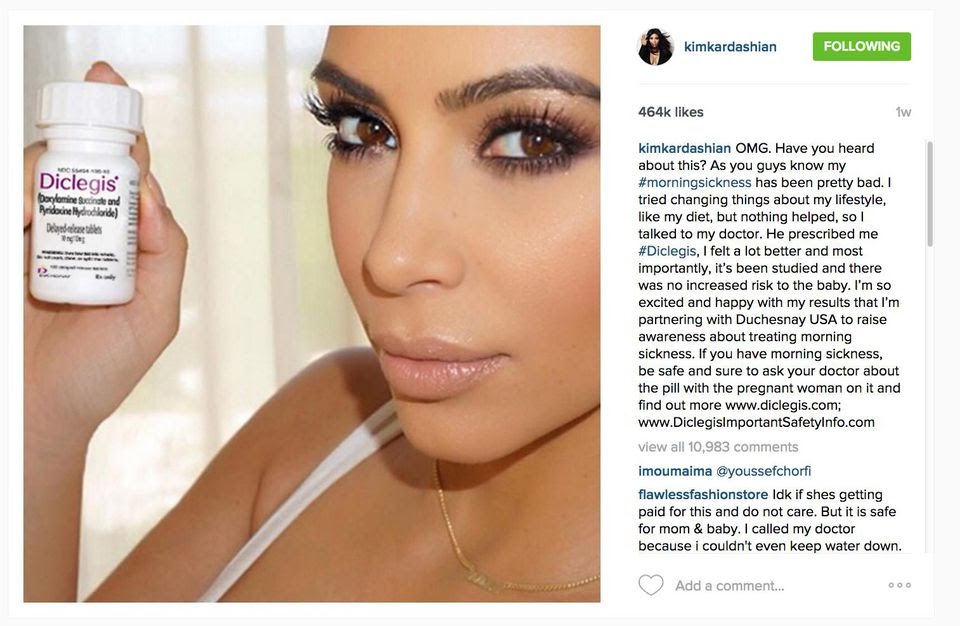
Image sourced from www.forbes.com
The conceit that a supermom influencer could properly promote a drug for moms without understanding the kinds of following that made up her base was, and still is, quite incredible, and had they listened to the consumers of their very own product, they may have avoided such a kerfuffle.
Pro Tip: Ideally, you want to partner with someone whose content doesn’t supplement your own branding and messaging, but can complement it. When utilizing social listening to better understand the makeup of an influencer’s following, make sure to focus on a few key things that are crucial for successful brand synchronicity: social media conversations (for direct messaging that can give you a better idea of how consumers react to an influencer’s content), location listening (so you can better understand where the bulk of their audience is coming from, and if that location aligns appropriately with your products, e.g. a sport-obsessed influencer’s soccer-heavy followers may be great to target if you have a large presence in the UK, but probably not Mobile, Alabama), and of course, consumer sentiment (for reasons that should be obvious).
2. Acquire Valuable Audience Feedback Through Targeted Listening
Social listening can be a great asset when trying to make sense of broad points of data, but the oft-overlooked tool of Targeted Listening can take a normal content campaign and make it shine. Just as the name describes, targeted listening focuses the efforts of a search query by condensing the variables within said search, thus providing a more focused set of results that can better inform your marketing strategies.
With targeted listening you can break down consumer data by keyword, by date and location, by age and gender segments, by profession, and even by something as granular as emotion. The benefits of such laser-focused listening can reap awesome benefits that allow Social Marketers to efficiently develop content that targets individuals who would actually be receptive, as opposed to content that’s considered to be generally favorable to broad swaths of the market. The many tools of social listening platforms allows for targeted listening, including a key term search system that can break down millions of social media posts into an easily understandable word graphic that can allow you to analyze the most positive sentiments related to a term.
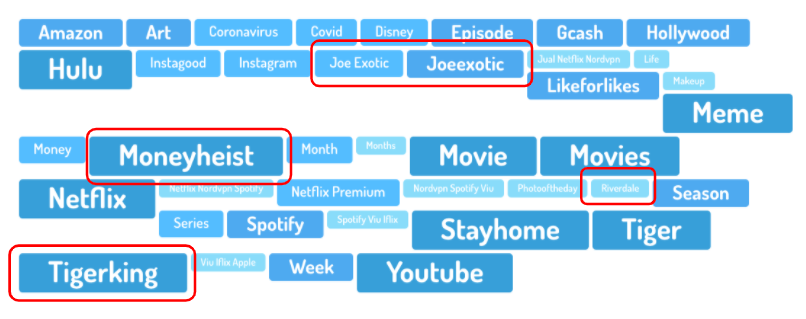
Digimind Term Search analysis on Netflix’s “Tiger King” documentary, showing off what can be gleaned from targeted listening - as evidenced with the red boxes.
Pro Tip: Targeted listening is only possible if you specify a timeframe for your query. Always remember to choose a window of months or years that are relevant for your search, otherwise you risk muddying the waters for what would otherwise be a very straightforward set of accurate data points with which you can acquire consumer insights that’re vital to your content strategy.
3. Develop Strong Ideas Through User-Generated Content
Businesses respond to consumers in many different ways, and one big way that businesses do so involves how they use their bank accounts. Truth be told, they’re not wrong in their assessments, but to only concentrate on the results of sales is to ignore ways in which to grow the brand’s creative content direction, and thus keep innovating new ways to increase that financial success. One way to customize your content to appeal most to prospective consumers, is by looking at, and understanding, the user-generated content that they themselves create.
User-generated content can come in many forms and can be induced by a brand via a competition or challenge, or completely spontaneous. From tribute songs, to fan art, to passion projects and imitation work, this kind of content may seem obviously natural if a product or service warrants such attention. But the key here is to accept the output that comes from these devoted users, and thus better position your own content to reflect their efforts. Posts on social media are the perfect place to research when discovering applicable examples of user-generated content, and using social listening can help you key in on when user-generated content trended most, and glean why it did. Knowing the when and why of a video’s popularity can tell you a lot, most importantly it can tell you if the example was a one-off event, or if it was indicative of a bigger consumer sentiment that should influence whatever content you come up with next.
This kind of content that reflects the output generated by users can act as both a palate cleanser between campaigns, and also a reminder that brands and businesses care about how consumers feel when it comes to their wants/needs. When appropriated effectively, you can provide your own content with an air of:
- Authenticity
- Relatability
- Spontaneity
- Quality
- And more…
Before becoming the unofficial snack chip of beloved adult sci-fi animated show, Rick & Morty, Pringles listened on social media to the trend of users repurposing their product’s cans into household DIY’s, a craze that became popular a few years back. They then turned around and encouraged the users to make it their own, eventually transforming the idea into a strange, but popular obsession on social media where some interesting concepts took to life and likes.
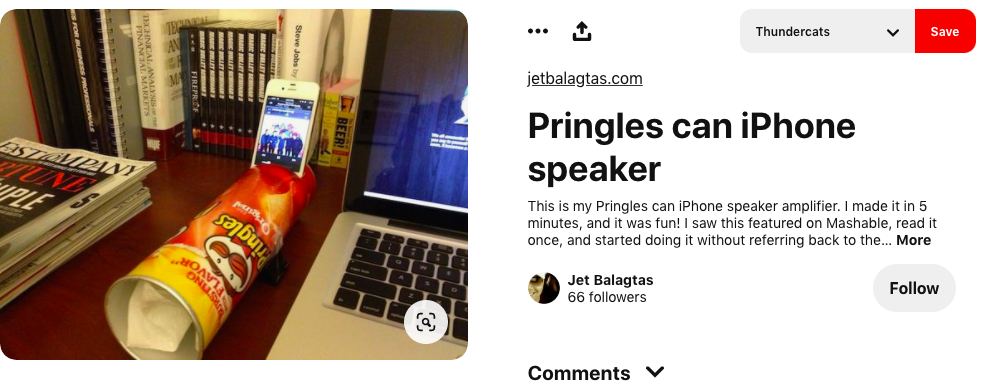
Image sourced from www.pinterest.com.
Pro Tip: With social listening and user-generated content, it’s important to note that it’s necessary to segment users based on the content generated, and then to narrow the search for content via the type relevant to your brand.
4. Focus On What’s Trending
This might seem very obvious, but what trends on social media is what matters on social media. It highlights a very important element found through social listening: relevance. Marketing is a lot of things, but being relevant is definitely one of the singular most key goals for a successful campaign. When you listen to the consumers on what’s hot at the moment, you’re doing two things: 1) showing your loyal target audience that you want to know their minute-to-minute needs/desires, and 2) that you’re willing to react with crucial content that reflects this fact.
Social listening aids with this process tremendously, through searches that can pinpoint keywords that relate to what consumers are most interested in on platforms like Twitter, Facebook, and Instagram. Spikes in conversations on something like the word “Nintendo”, can reveal when people were most mentioning the company, and for what reason. If you know what is trending, and how that looks on social media, you can better adjust your own content campaign to appeal to the trend. By staying relevant, you are in a better position to speak to consumers, hear their issues, and make smart choices on future campaign options.
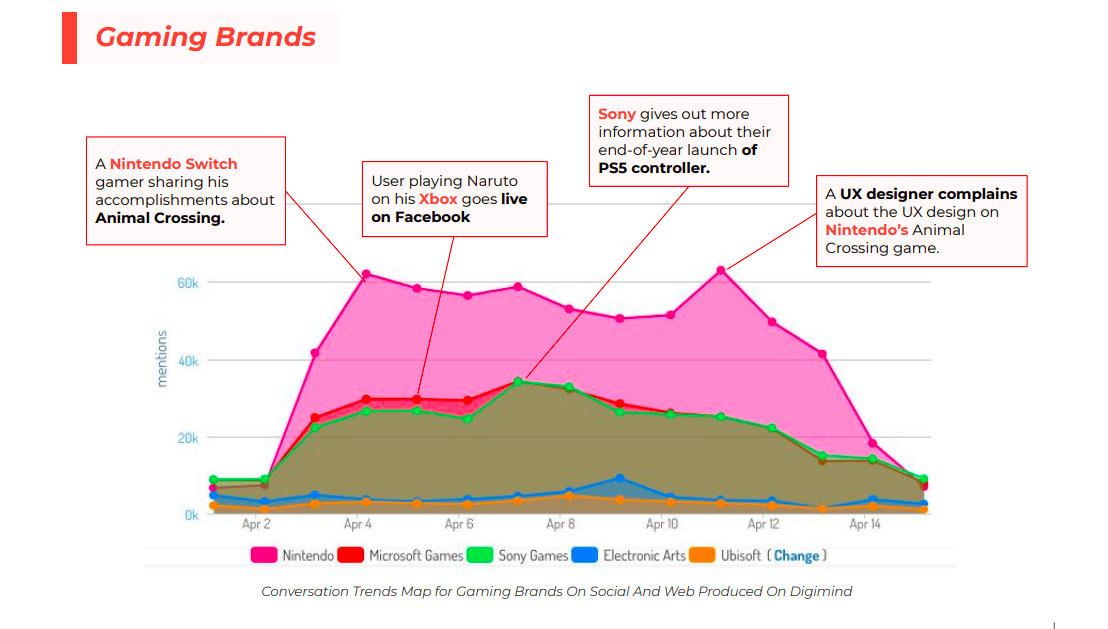
Digimind conversation graph showing a trend of spiking conversations regarding their pandemic-released Nintendo Switch game.
For example, going back to Nintendo, a huge example of this strategy in effect involved a video game release called “Animal Crossing: New Horizons”. The buzz around the game was so incredible that this influenced the company to create a unique Instagram account for all of the villager NPC’s (Non Player Characters) in the game, as a definite affirmation of the success for the game and loyal fanbase, both online and off.
Pro Tip: Like anything in life, use discretion when hunting trends with social listening. Just because something is trending, doesn’t mean that it’s for a good reason. Negative publicity or high coverage of a product or service on social media doesn’t necessarily warrant a brand’s attention. And creating negative or even playfully mean content in reaction to something trending can negatively impact your own brand image as well. Stay classy, and stay positive with your content. Remember that you’re always being perceived by consumers in the light you put yourself under. Make sure it’s a good one.
5. Discover And Utilize Consumer Sentiment For Competitor Content: See What Works And What Doesn’t
Social listening is a science of both statistics and human behavior, which means its accuracy provides a level of insight that can’t be found elsewhere. Use that definiteness to your advantage and develop strong content strategies that consider the competition. Developing a 360 degree campaign that only includes the sentiments of your own consumer base leaves out an entire ocean of potential customers who are ripe for conversion. Untapped sources of new revenue and followings can (and should) come from the conversion of your competition’s own audience, and this will take efficient use of social listening to glean key insights about what is and isn’t working for the competition. With that knowledge you can adjust your own content to cater to their dissatisfaction. Basically, if you can’t beat them, convert their consumer base to yours.
By listening to the opposition, you can:
- Quickly anticipate what they might say about your own brand, and deftly outmaneuver their denigration efforts with real, physical product/service concessions or changes to that can instantly create user appeal.
- One-up the competition on social media, with messaging that understands the scope and limitations of their content, and builds off that with bigger or better marketing campaigns.
- And, most importantly, see what mistakes or slip-ups your competitors have made, and thus avoid them so that the chance of brand crises is mitigated.
Pro Tip: One thing that should be clear when engaging in competitive social listening, is to listen for ALL consumer sentiments, and not just cherry pick the ones that seem relevant to your business model. To see this in action, let’s look at two separate hypotheticals:
What works: You run a social listening query on something as innocuous as “pricing” for a competitor’s consumer base. You discover that customers are most satisfied with the different “pricing models” given for consumer choice, but most annoyed with the “high prices” for some of their products via the conversations on Facebook and Twitter. So you develop a marketing campaign that creates content to advertise your similar product(s) for a lower price. People take note and you’re suddenly seeing your brand enjoy the success of new consumers that once belonged to your competition.
By understanding what is relevant with consumers as an actual point of contention, then you effectively make that content work through proper social listening.
What doesn’t work: A competitor is seeing more success than your business because of a new service update that your company has offered for a while, but hasn’t seen as much traction because it’s old news. After listening to the positive user sentiments surrounding the topic of “new” for this service, you figure it’s time to repromote your old service with some relevant content marketing. But the competition still ekes out more business than you anyways because you failed to also listen to their negative impressions surrounding the topic of “quality”, which was overshadowed due to the allure of it being freshly released.
Try seeing the entire picture, and not just the obvious points of competitive campaigning. There’s so many separate tools at your disposal with social listening, and a platform like Digimind can give you accurate consumer insights from many different angles. Take advantage of everything, and never narrow your scope.
For Success, Just Listen, Analyze, And Act Accordingly
Creating content is easy enough if you’re well equipped to do the job. Creating strong, socially-informed content is also easy if you know what you’re doing and have the right tools to support your efforts. A pizza cook doesn’t make pizza without a pizza oven, a painter doesn’t paint a masterpiece without a canvas, and a someone who claims they’re in marketing should know better than to attempt their profession without social listening tools to develop successful content that works. Social Marketers, Brand Strategists, and Consumer Insights professionals have serious challenges in the form of lightning-fast turnarounds for social media trends, and a field of bloated, rehashed ideas that have flooded the content market. The only way around this is to remain reactive when it comes to social listening, and Digimind can be a great weapon in that fight.
Just having the tools for the job however means nothing if you can’t take full advantage of said tools, so remember to always be searching for strong influencer partnerships, that includes the sentiments of their followers, continue to utilize targeted listening for the strongest consumer insights, inform your content concepts through user-generated content, focus on what’s trending, and make sure to rely on competitive listening to better position your future content campaigns for better outcomes.
Written by Micah Levin
With a background in creative writing, advertising, and psychology, Micah is a copywriter in name and a Digiminder at heart. When he's not developing content for agencies, you can find him crafting novels, cooking and running around in Brooklyn, NY.


